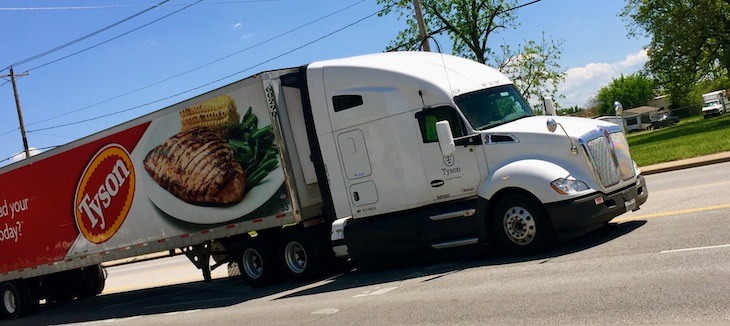Record growth through 2019 predicted by Tyson Foods boss despite rising costs
by May 16, 2018 5:37 pm 557 views

Tyson Foods President and CEO Tom Hayes said while the company’s raw material costs will fluctuate the mission to achieve volume growth, margin expansion, more unit sales and year-over-year earnings growth doesn’t change.
“Flat is not the new normal at Tyson Foods,” he said Wednesday (May 16) during his opening comments at the 13th Annual Farm to Market Conference hosted by BMO Capital Markets in New York.
He said the company’s growth algorithm begins with value-added volume, which is pegged at 3% this year and also should foster high single-digit earnings per share growth.
Hayes said the company also will focus on eliminating unnecessary spending and look for more acquisitions that help the company’s long-term growth. He said the recent $850 million purchase of American Proteins and AMPRO fit nicely into Tyson Foods’ portfolio.
“It’s a sweet deal for us,” Hayes said. “We already have a business just like it and this will allow us to quickly expand our capacity for recycling chicken parts rendered into animal feed, aquaculture and items like crayons and chapstick. It’s a strong business and we needed the extra capacity.”
From a financial perspective, Tyson Foods CFO Stewart Glendinning added, “The return is very strong. The acquisition multiple is about 10X. We got a good price and we expect synergies to ramp up by year three with substantial value creation in this business. The synergies are driven in areas we know well because this a business we already run.”
Glendinning said savings from synergies are driven by operating the business at a lower cost and boosting product margins in the acquired busines. He didn’t provide dollar estimates of expected savings but said the deal will boost income in year one.
When asked to discuss any negative impacts to earnings in the back half of 2018 and into 2019, Hayes said freight costs are expected to cost the company $155 million this year. He said the rising freight costs can’t be recovered through price increases and are a about 31 cents per share hit to earnings.
He also said the shortfall in hatchery production facing the entire industry is a drag because demand for processed chicken remains high. The U.S. Department of Agriculture (USDA) recently estimated that eggs hatched per layer hen in the first quarter were down about 2.8% from last year. While there is a larger inventory of layers, production remained flat. The USDA reports in the past two quarters bird slaughter growth fell behind the increase in the birds available by 2.7% in fourth quarter of 2017 and 1.2% in the first quarter of 2018. The USDA reports hatchery supply flocks were down 3% in February and down 2% in March compared to a year ago. The lower hatchery flock numbers can impact production into next year.
Hayes said there is no solution for the hatching shortfall as it relates to birds genetically engineered to have more breast meat yield and higher feed conversion rates. The new genetic line should strengthen and when that happens there will be a substantial payoff.
Hayes also said weather is a wildcard that in any year could impact grain costs and live cattle supplies. He said Tyson Foods management is focused on total shareholder return which include dividends, earnings growth supporting higher stock prices, and discretionary share buybacks the company will continue when it’s prudent to do so. He said there is still a healthy appetite for acquisitions to help Tyson position itself for continued long term growth.
“We see 2019 setting up to be another really good year at Tyson Foods,” he said.
Shares of Tyson Foods (NYSE: TSN) rebounded Wednesday (May 16) closing at $68.56, up $1.28 on lower than usual volume. For the past 52 weeks Tyson shares have traded between $57.20 and $84.65. Wall Street pegs the stock’s one year target price at $81.81.
